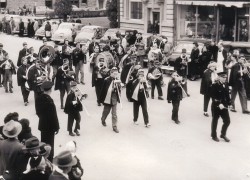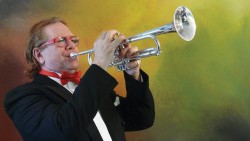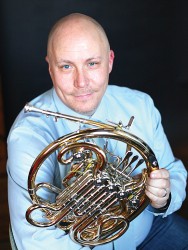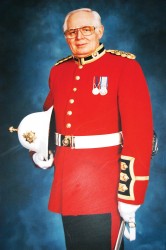Hannaford’s BrassFest is Back
As i sit down and stare at the blank screen, we have had our four beautiful days of summer complete with crocuses in the garden and it’s now back to the reality of spring. It’s time to come out from under the rocks and see what is happening in the band world. For many, it’s transition time from the more formal concert format of the fall and winter programming before the summer events begin. For others there is probably still a final spring concert looming first. Unfortunately, Murphy’s Law seems to be working in our band world this spring. We have two significant major concerts the same date and time in downtown Toronto.
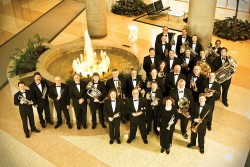 This leads us to the one big spring event in our band world. It’s the Hannaford Street Silver Band’s annual Festival of Brass 2012 version from Friday April 13 through Sunday April 15. It’s bigger than ever this year. As in past years, on the Friday evening there will be “Rising Stars” at the Church of the Redeemer where members of the Hannaford Youth Program will perform under the direction of Anita McAlister. This concert will also include the final round of their annual Solo competition. The winner of this will perform with the HSSB on the Sunday concert.
This leads us to the one big spring event in our band world. It’s the Hannaford Street Silver Band’s annual Festival of Brass 2012 version from Friday April 13 through Sunday April 15. It’s bigger than ever this year. As in past years, on the Friday evening there will be “Rising Stars” at the Church of the Redeemer where members of the Hannaford Youth Program will perform under the direction of Anita McAlister. This concert will also include the final round of their annual Solo competition. The winner of this will perform with the HSSB on the Sunday concert.
On Saturday afternoon it will again be “Community Showcase” where community bands from across Ontario and beyond will perform a wide range of repertoire. Some bands will also vie for the Hannaford Cup, the HSSB’s annual award for excellence. Individual members of some of these groups will compete in the band’s annual Slow Melody contest. The winner of this competition will perform with the HSSB on Sunday. On Saturday evening, the Canadian Staff Band of the Salvation Army, under the direction of bandmaster John Lam returns to the festival. As soloist, tuba showman extraordinaire, Patrick Sheridan, will dazzle the audience with his virtuosity .
As in past seasons, the grand finale will be the Sunday afternoon concert, “Dreaming of the Master.” Here, Sheridan will switch roles from soloist, and make his debut as guest conductor of HSSB. In this concert there will be two soloists. Canadian trumpet virtuoso, Jens Lindemann, will return to the Hannaford stage in a performance of Canadian composer, Allan Gilliland’s Dream of the Master for Trumpet and Brass Band. The other soloist will, of course, be the winner of the Youth Band’s Solo competition.
As if this were not enough, this year HSSB has added some new features. On Thursday April 12 there will be “Education Concerts” for students at 11am and 1pm at the Toronto Centre for the Arts. We have heard rumours that the morning event is already sold out. The other new event will be a masterclass on Saturday April 14 at 9:30am at the Jane Mallett Theatre. This will be a free public event where Lindemann and Sheridan join forces to impart their wealth of musical performance expertise to all in attendance.
The Hannaford Street Silver Band is to be congratulated for its efforts in bringing the unique sounds of the brass band to a wider audience, and for its outstanding contribution to the enrichment of the musical lives of the participants in their junior bands.
For a very different kind of band music we have the Silverthorn Symphonic Winds and their concert offering of “Ballet, Broadway, and the Big Screen.” This concert will feature the world premiere of a new transcription of Sherwood Legend, for solo French horn and wind ensemble, by Canadian composer and oboist Elizabeth Raum. This transcription, commissioned by Silverthorn Symphonic Winds, will feature artist-in-residence Christopher Gongos on French horn. The concert takes place at 2pm, Sunday April 22 at the Richmond Hill Centre for the Performing Arts. A free pre-concert talk with composer Raum and Gongos will begin at 1:15pm.
Another event of interest to band musicians offered by Silverthorn Symphonic Winds is a free public music clinic, in conjunction with the Westmount Collegiate Music Department and Arts Westmount Music. Led by Gongos, “Brass Boot Camp and Beyond” will provide tips on musicianship, technique and ensemble playing. The clinic takes place on Thursday April 12, 7pm, at Westmount Collegiate Institute, 1000 New Westminster Dr., Thornhill.
Brass musicians should bring their instruments to participate in an ensemble led by Gongos. Other musicians will also benefit from the clinic and are encouraged to attend as audience members. The content of the clinic will be geared toward high school instrumentalists and adult amateur musicians. It is free and open to the public. For more information, contact pr@silverthornsymphonicwinds.ca. This is the kind of effort which could, and should, be undertaken by more community musical groups. It is the sort of initiative that will frequently qualify for funds from granting agencies and will endear the band to the community at large.
The Royal Regiment of Canada, the biggest Reserve regiment in the Canadian Army, is celebrating its 150th anniversary this year (which they didn’t tell our listings department about, alas). In any case, on Sunday, April 15, 2pm, the Regimental Band will present its “150th Anniversary Gala Concert” at Koerner Hall at the Royal Conservatory. The concert will feature the Band of The Royal Regiment of Canada, emcee Jacquie Perrin of the CBC, and special guests the Pipes and Drums of the 48th Highlanders of Canada, singer-songwriter Jon Patterson, vocalist Danielle Bourré, and a specially-formed Regimental Chorus composed of Afghanistan veterans and other serving infanteers. To dovetail with the concert, the Band of The Royal Regiment of Canada will be releasing a new double-CD, Saeculum Aureum (Golden Age), their sixth recording in the last 15 years. And there will be a pre-concert luncheon in Hart House on the University of Toronto campus.
Who said that community bands were dead? Last month I reported on the formation of the new Aurora Concert Band, and hope to visit them some Sunday evening soon. Now, a few days ago, I heard from a band that has been operating for over a year, but has just contacted us. The Columbus Centre Concert Band, under the direction of Livio Leonardelli was formed in November 2010 and has grown to more than 40 regular musicians. They performed five concerts in 2011 and have currently booked for five in 2012. Their diverse repertoire ranges from Verdi and Puccini through Count Basie and Sinatra, to Broadway musicals. They rehearse every Tuesday evening from 7:30pm to 9:30pm at the Columbus Centre and are particularly interested in attracting a few more low brass players. For information contact Fred Cassano at fred.cassano@ca.pwc.com or at 416-828-3733.
Definition Department
This month’s lesser known musical term is The Right of Strings: The Manifesto of the Society for the Prevention of Cruelty to Violists.
We invite submissions from readers. Let’s hear your daffynitions.
Jack MacQuarrie plays several brass instruments and has performed in many community ensembles. He can be contacted at bandstand@thewholenote.com.


